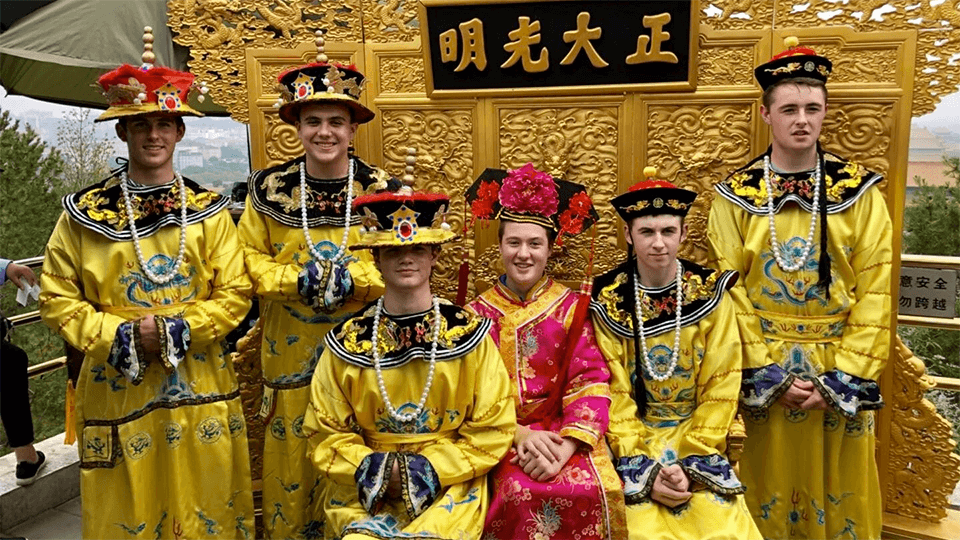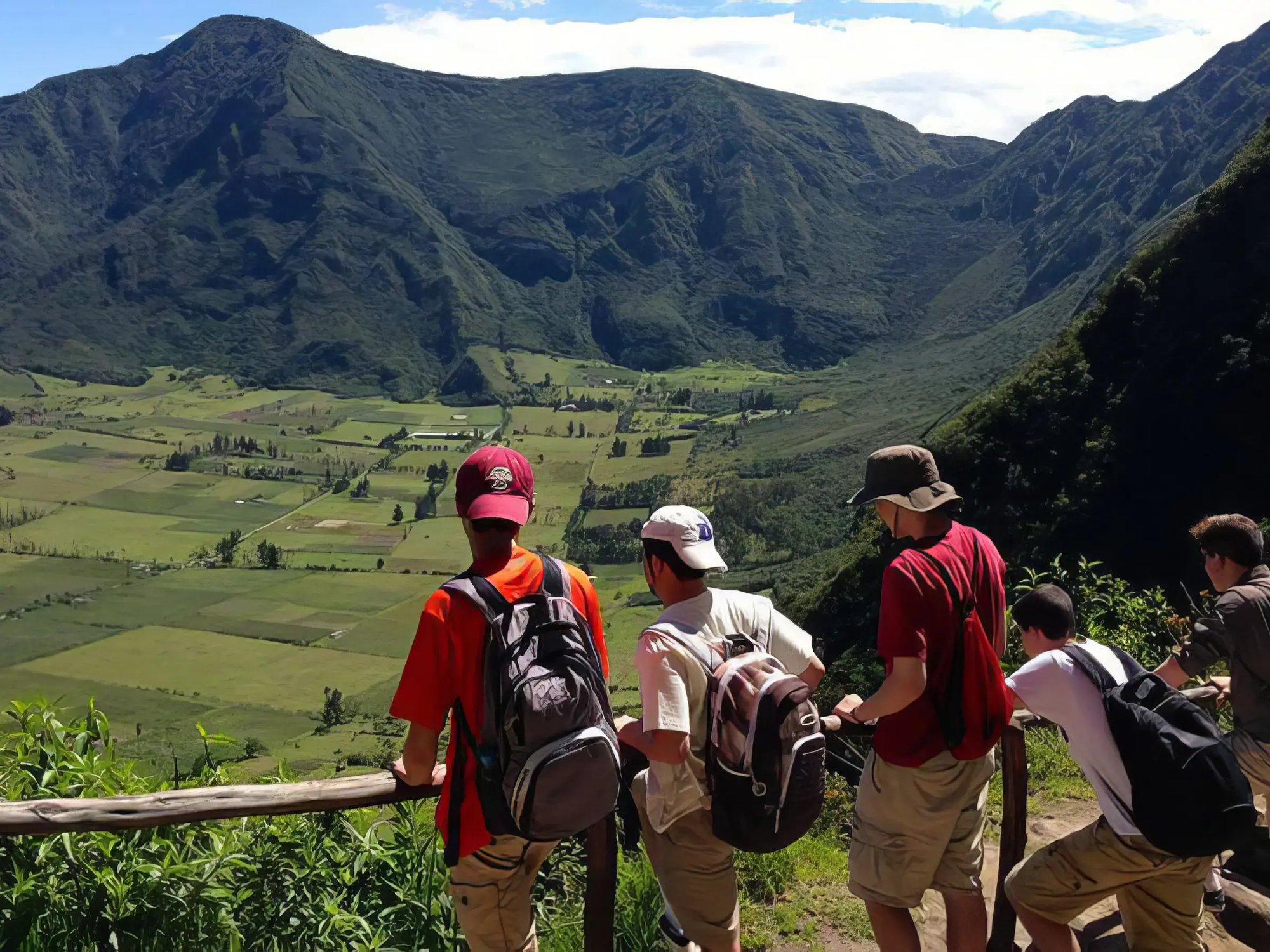Lawrence H. Hyde '42 Center for Global Education

Expanding Horizons, Empowering Change
At BC High, we believe that learning extends far beyond the classroom. Since 2012, the Lawrence H. Hyde ’42 Center for Global Education has provided students with transformative travel and immersion opportunities that foster a deeper understanding of the world. Complemented by our Global Citizenship Certificate Program, these experiences encourage students to engage with diverse cultures, broaden their perspectives, and cultivate the skills and values needed to make a meaningful impact. Our mission is to provide real-world experiences that challenge assumptions, enhance self-awareness, and inspire students to become agents of change in our interconnected world.
From the vibrant streets of Argentina to the cultural richness of Vietnam, BC High students have the chance to explore over a dozen countries globally. But it’s not just about international travel—our domestic programs, like those in Brownsville, TX, give students the opportunity to engage with diverse communities, broaden their worldview, and connect with people from different backgrounds.
Our mission is clear: we aim to inspire students to return from these experiences with the skills, insights, and passion to make a meaningful impact in the areas of social, environmental, and economic change. These experiences are not just trips—they’re catalysts for transformation, both for the students who take them and for the communities with which they engage.
The Hyde Scholars program has been pivotal in shaping who I am as both a person and a global citizen. Through diverse experiences and lessons, I've gained a deeper understanding of the interconnectedness of our world and my role within it. This journey has equipped me with the skills and mindset to contribute meaningfully to global challenges, and I am committed to continuing this work. In today’s world, being a globally informed citizen is not just important, it’s essential for creating a better future.

Explore the world.
Discover new countries, languages, and traditions.
Transform into a global citizen.
-

Argentina
Whether it is through dancing the Tango, or visiting a local ranch with real gauchos, students truly feel a part of the lively and welcoming Argentinean culture. -

Belize
Come together with fellow juniors to build a house for a family living below the poverty line in Belize City. During this week-long service trip you’ll gain construction skills, visit with kids in a daycare center who are struggling with poverty and disease. -

Costa Rica
In this one-of-a-kind adventure program for Arrupe students, you can getto know Costa Rica’s famous coast-to-jungle ecosystem through ninedays of kayaking, zip-lining, and treks to volcanos and hot springs. You’llround out your nine-day adventure with a visit to a local school. -

Dominican Republic
During this week-long service trip, you’ll work directly with a local community to improve access to quality water, visit an orphanage, assist Jesuit ministries at the Haitian border, and stay with a host family to truly experience life in this beautiful island country. This experience is open to juniors only. -

Ecuador
Working hand-in-hand with The Working Boys Center in Quito, Ecuador’s capital, you’ll spend a week providing vocational training and life skills to the working children of Quito. This week-long program, open to juniors, offers both retreat and service credit. -

France
Spend two weeks in scenic Lyon, France. Brush up on your language skills, explore the city’s rich culture and history, and sample the finest in French cuisine at the co-ed Lycée Saint-Marc. -

Greece
Students studying Greek can spend one week visiting iconic sites such as the Athenian Agora, the Acropolis, and the archaeological site of Delphi.You’ll even get the opportunity to declaim Homer in a Greek theater, see where the apostle Paul delivered a sermon, and walk through the ancient ruins of the Parthenon. -

Guatemala
The Guatemala Service Immersion experience partners with Nuestros Pequeños Hermanos (NPH USA). Juniors will experience a one week service opportunity serving in an NPH orphanage. -

Ireland
During this two-week academic exchange, you’ll attend classes at Belvedere College, SJ in Dublin and have the chance to explore the literature, arts, history, sport, and culture of Dublin and surrounding areas. -

Italy
The Rome Latin Seminar invites classics scholars to spend a week inRome exploring the Colosseum, Vatican Museum, and St. Peter’s Basilica,among other sites. If you’ve always wanted to declaim Cicero in theRoman Forum or walk through the ruins of the Pantheon, this is your trip. -

Vietnam
In this ten-day program in Hanoi and Hue, you’ll work alongside BlueDragon, a local foundation working with street children around issues of human trafficking. You’ll also explore Hue by bicycle, experiment with traditional fishing on bamboo canoes, and learn about Vietnamese farming and cooking. -

Scotland
Focusing on our common Jesuit roots, traditions and relationships, we expect this program to introduce participants to the transformative nature of global experiences through building strong relationships within the Jesuit network. During this program, students will stay with host families, participate in a daylong retreat, attend classes, explore both Glasgow and Edinburgh, and engage in St. Aloysius’ outdoor educational program! -
China
-
Brownsville, TX
-
India
-
Cape Verde
-
Rwanda
-
Australia
-
Canada
A World of Opportunity
The Hyde Center for Global Education offers transformative educational, retreat, and service experiences across five continents. Whether you’re an experienced traveler or embarking on your first international journey, our programs invite you to immerse yourself in diverse cultures and discover how these experiences can inspire you to make a difference in the world. From service opportunities that foster global citizenship to cultural immersion and exchange programs that deepen your understanding of the world, the Hyde Center is your gateway to impactful, life-changing exploration.
Service: Through our service programs, students walk alongside those we strive to serve in hopes of expanding their understanding of themselves, learning about the world from different cultures, and recognizing their role as global citizens aspiring to make the world a more just place.
Places we travel for service trips:
- Belize
- Brownsville (in partnership with Center for Ignatian Identity and Formation)
- Cape Verde
- Dominican Republic
- Ecuador
- Guatemala
- Vietnam - also considered a cultural experience due to the length of the trip and dual focus
Exchange: Our exchange programs offer our students a unique opportunity to experience different cultures by hosting a student from a partner, Jesuit school and then traveling to that same student’s home, to “live like a local” by attending classes, exploring the area, and visiting museums and historical sites.
Places we travel for exchange trips:
- Argentina
- France
- Ireland
Cultural Immersion: Our immersion programs focus on the culture of the destination and are designed to provide experiences that push our participants to recognize and appreciate difference, by learning about the history, politics, economy, and values of the country they are visiting.
Places we travel for our cultural immersion trips:
Cultural Immersion:
- China
- Vietnam
- Greece/Italy
- Costa Rica

Featured Trip: Buenos Aires
Whether you’re eating authentic chimichurri sauce or visiting a local ranch with real gauchos, you’ll get the full Argentinian experience in this month-long introduction to the rich history and thriving culture of Buenos Aires.
The Buenos Aires program includes Spanish classes and language immersion, Argentinian history and culture classes, and weekly excursions both in and around the incredible city. As an exchange student staying with a host family, you’ll get a true inside look at day-to-day life in this stunning city at the edge of the Atlantic Ocean in southernmost South America. You’ll learn the language and customs, eat home-cooked food, and discover just how much two very seemingly different cultures can have in common.
As we offer this program as a true exchange, families are encouraged to host a student from Buenos Aires prior to travel. BC High students have an amazing opportunity to develop strong friendships with their host brothers, who they will stay with while in Argentina. While the Hyde Center makes an incredible effort to provide life-changing experiences for students, most will agree that staying with a host family becomes the most transformational element of this program.
BC High Students, Global Citizens
Established through a generous gift from BC High alumnus Mr. Lawrence H. Hyde ’42 in 2012, the Hyde Center for Global Education offers one-of-a-kind educational, retreat, and service experiences across five continents. No matter your level of experience and comfort with international travel, we encourage you to apply to our unique Hyde Center programs, and discover the many ways that immersing yourself into the world’s cultures can inspire you to change it.
A Path to Becoming a Citizen of the World
The Hyde Global Scholars program is a globally minded path through BC High. By participating in international travel, showing a commitment to a second language, and expanding their concrete knowledge on global issues, Hyde Scholars will reflect on their personal journey of what it means to be a citizen of the world.
¿ Hablas español? The Pope Francis Scholars are a group of students committed to studying conversational Spanish for three academic years, beginning with the summer prior to freshman year at BC High.
While there will be differences in the way that these students develop their skills, the ultimate outcome is for them to exhibit advanced linguistic proficiency and heightened cultural awareness by the time they begin senior year. Through their enthusiasm and commitment to the study of the language, these students provide critical leadership and serve as role models for their peers in their language classes.
Students will:
- Increase their level of conversational Spanish skills by meeting weekly with Spanish-speaking members of our faculty & staff
- Enhance their confidence and proficiency in Spanish
- Understand their own culture by exploring others
- Increase their creativity
- Enhance their skills in their traditional Spanish course
Stay inspired and engaged
Follow BC High’s Centers of Human Excellence on social media!
Meet Lawrence H. Hyde ’42
Through a generous gift from alumnus Lawrence H. Hyde ’42, BC High established the Hyde Center for Global Education in 2013. A strong believer in the transformative nature of international travel, Larry Hyde traveled to every country recognized by the United Nations before his death in 2018. His desire was for all BC High students to have global experiences that would expand their horizons.
While BC High already offered some international exchange programs, the school’s ability to incorporate travel into the student experience was vastly expanded through his investment. The launch of the Hyde Center was a turning point in BC High’s history, firmly establishing global education as an institutional priority for our students and igniting a new spirit of collaboration between the more than 800 schools in the worldwide Jesuit school network.